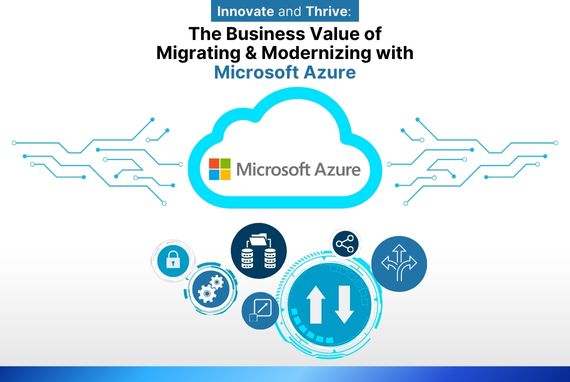
Innovate and Thrive: The Business Value of Migrating and Modernizing With Microsoft Azure

Erik Ruda
06 Feb, 2024
In the ever-accelerating digital transformation era, businesses are racing to adapt and remain competitive within a dynamic and interconnected global landscape. The importance of embracing digital technologies cannot be overstated, with data from Statista revealing that global digital transformation spending is projected to reach an estimated 3.4 trillion U.S. dollars by 2026, underscoring the urgency and significance of this ongoing revolution.
The Role of Cloud Computing in Business Innovation
Cloud computing has emerged as a catalyst for business innovation, enabling organizations to harness the power of scalable and flexible IT resources. According to Gartner analysts, more than 85% of companies are projected to adopt a cloud-first approach by 2025, further solidifying cloud computing as a cornerstone of modern business strategies. This shift is instrumental in fostering innovation and ensuring competitive advantage.
Microsoft Azure as a Leading Cloud Platform
Amidst the plethora of cloud providers, Microsoft Azure continues to shine as a leading cloud platform, renowned for its robust capabilities and global reach. As of 2024, Azure maintains its status as a trusted choice for businesses, with more than 95% of Fortune 500 companies relying on Azure services to power their digital transformation initiatives. Its extensive global presence, with data centers in numerous regions, ensures accessibility and reliability for organizations worldwide.
In this article, we will explore the benefits that your business can gain by moving to and modernizing with Microsoft Azure. We will break down the important steps for your successful migration and modernization, showcasing the clear advantages of choosing Azure as your preferred cloud platform.
Additionally, we will tackle common challenges during migration and share the latest best practices to overcome them. In a time where innovation is crucial, we want to emphasize how Azure can drive innovation and how it remains relevant in today’s rapidly changing landscape of 2024.
The Need for Migration and Modernization
Key Considerations Before Embarking on the Journey
- Assess Existing Infrastructure: Begin by taking a comprehensive inventory of your current IT infrastructure. Identify areas in need of upgrade and those that can remain unchanged. This assessment will serve as the foundation for your migration strategy.
- Define Business Objectives: Clearly articulating your business objectives is essential. Determine whether your primary goals include improved scalability, cost savings, enhanced security, or a combination of these benefits. This clarity will guide your migration process effectively.
- Craft a Comprehensive Migration Strategy: A successful migration requires careful planning. Just as you wouldn’t embark on a road trip without a map, your migration strategy should outline each step of the process. Determine what resources will be relocated, their destinations, and the timeline for execution.
Microsoft Azure Migration Tools and Services
Now, let’s delve into the tools and services that Microsoft Azure offers to facilitate a smooth migration process.
- Azure Migrate: Think of this as your navigator. Azure Migrate helps you discover, assess, and plan your migration. It gives you insights into your current environment, making the transition smoother.
- Azure Site Recovery: This is like your safety net. It ensures business continuity by replicating your workloads to Azure. If something goes wrong, your data is safe, and downtime is minimized.
- Azure Database Migration Service: If you have databases to move, this is your go-to. It simplifies the process, minimizing downtime and ensuring your data arrives intact.
Understanding the migration and modernization process is the first step in your journey to harness the power of Microsoft Azure. With effective planning and Microsoft Azure’s tools, you’re on the right track for a successful migration.
The Benefits of Migrating to Microsoft Azure
1. Cost Savings and Scalability
- Pay-as-You-Go Pricing Model: Azure’s pay-as-you-go pricing is like having a flexible budget. You pay only for what you use, which means no more overpaying for idle resources. It’s cost-efficient and helps you allocate resources wisely.
- Scalability and Elasticity: Need to scale up during peak times and down during slow ones? Azure’s scalability and elasticity have got you covered. You can adjust your resources as your business demands change, ensuring you’re always right-sized.
2. Improved Security and Compliance
- Azure Security Center: Security is a top priority, and Azure Security Center is your unwavering sentinel. It provides advanced threat protection across your Azure environment, helping you stay one step ahead of cyber threats.
- Compliance Certifications: Azure boasts a plethora of compliance certifications, including GDPR, HIPAA, and ISO 27001, among others. This means you can trust Azure to meet stringent regulatory requirements.
3. Enhanced Agility and Innovation
- Azure DevOps: Want to speed up your software development and deployment? Azure DevOps streamlines the entire process, from coding to testing to delivery. It’s the fuel for your innovation engine.
- Azure Kubernetes Service: Embrace containerization and microservices effortlessly with Azure Kubernetes Service (AKS). It simplifies managing and orchestrating containers, so you can innovate faster and stay agile.
4. Business Continuity and Disaster Recovery
- Azure Backup: Protecting your data is non-negotiable. Azure Backup ensures your critical data is always backed up and recoverable.
- Azure Site Recovery: Disasters can strike at any time. Azure Site Recovery keeps your applications and workloads safe by replicating them to Azure. When the unexpected happens, you can bounce back swiftly.
Modernization and Transformation with Azure Services
1. Application Modernization
- Lift and Shift: This approach allows you to swiftly migrate your existing applications to Azure without making significant changes. It’s like moving your entire house to a new location while keeping everything intact. This method is perfect for businesses seeking a quick transition to the cloud while preserving the status quo.
- Re-platforming: Sometimes, your applications need a little makeover. Re-platforming involves optimizing your apps to take advantage of Azure’s cloud-native features. It’s akin to renovating your house— improving its efficiency and functionality while retaining its core structure.
- Containerization and Microservices: If you’re aiming for agility and scalability, containerization and microservices are your best friends. Think of it as building with LEGO blocks rather than a monolithic structure. Azure simplifies the management of containers with services like Azure Kubernetes Service (AKS), enabling you to break down your applications into manageable microservices.
2. Data Modernization
- Azure SQL Database: When it comes to managing and scaling your databases, Azure SQL Database is your go-to solution. It offers a fully managed, intelligent, and scalable database service that ensures high availability and security. Migrating to Azure SQL Database can optimize performance while reducing operational overhead.
- Azure Cosmos DB: For globally distributed and highly responsive applications, Azure Cosmos DB is the answer. It’s a globally distributed, multi-model database service designed for mission-critical applications. With Cosmos DB, you can ensure low-latency access for users worldwide.
- Azure Data Factory: Data is the lifeblood of modern businesses. Azure Data Factory provides a flexible and scalable platform for data integration and transformation. It simplifies the process of orchestrating and automating data workflows, ensuring that your data is always available when you need it.
3. AI and Machine Learning Capabilities
- Azure Machine Learning: To stay ahead in today’s competitive landscape, harnessing the power of AI and machine learning is essential. Azure Machine Learning empowers you to build, train, and deploy machine learning models at scale. You can leverage this service to gain valuable insights, make predictions, and automate decision-making processes.
- Azure Cognitive Services: With Azure Cognitive Services, you can infuse AI into your applications to understand, interpret, and interact with human language. Whether it’s speech recognition, computer vision, or natural language processing, Azure Cognitive Services makes it easy to integrate AI capabilities into your solutions.
Overcoming Challenges and Best Practices
Common Migration Challenges
- Data Transfer and Latency Issues: Moving large volumes of data to the cloud can be a cumbersome task, leading to data transfer bottlenecks and potential latency problems. In 2024, businesses are dealing with ever-growing datasets that require efficient transfer solutions.Solution: Opt for Azure Data Box, a physical data transfer device that simplifies large-scale data migration. Additionally, leverage Azure’s Content Delivery Network (CDN) to reduce latency for end-users.
- Security Concerns: Security remains a top priority, and migrating sensitive data to the cloud can raise concerns about data breaches and compliance in today’s evolving threat landscape.Solution: Utilize Azure Security Center to continuously monitor and protect your cloud resources. Implement data encryption and access controls to safeguard sensitive information.
- Skill Gap: The rapid evolution of cloud technology often outpaces the skills of IT staff. Addressing the skill gap is more critical than ever. Solution: Invest in comprehensive training and upskilling programs for your IT team. Microsoft offers Azure certification programs and training resources to bridge the skill gap effectively.
Best Practices for a Successful Migration and Modernization
Comprehensive Planning: Rushing into migration without a well-thought-out plan can lead to complications. A comprehensive migration strategy is essential, serving as the blueprint for a smooth transition to Microsoft Azure, ensuring minimal disruptions to your operations.
Best Practice: Conduct a thorough assessment of your existing infrastructure, define clear objectives, and develop a detailed migration plan. Consider a phased approach to minimize disruptions.
Training and Upskilling: Equipping your team with the right skills is paramount for success, especially in the ever-changing technology landscape.
Best Practice: Invest in Azure-specific training and certification programs for your IT staff. Encourage continuous learning to keep pace with Azure’s evolving features and capabilities.
Continuous Monitoring and Optimization: Your Azure journey doesn’t end with migration; it’s an ongoing process. Optimizing your cloud resources is vital to control costs and maintain efficiency.
Best Practice: Implement continuous monitoring tools to track resource usage, identify bottlenecks, and detect security threats in real-time. Regularly review your cloud architecture and adjust resources as needed to ensure cost-effectiveness.
By acknowledging and proactively addressing these challenges while adhering to best practices, your migration and modernization with Microsoft Azure will have smoother transitions, enhanced security, and long-term efficiency gains.
In conclusion, migrating to and modernizing with Microsoft Azure is a strategic imperative for businesses. As highlighted throughout this article, Azure empowers organizations to innovate, optimize, and remain competitive. By embracing Azure and adopting best practices, businesses can position themselves for growth, enhanced security, and sustained success in the digital age.
Ready to make the most of Microsoft Azure for your business? Contact Rizeware Solutions and its team of dedicated experts today to ensure your digital transformation is a resounding success. Let’s embark on this Azure journey together and thrive!
Official Info
-
110 SE 6th St., Suite 1761
Fort Lauderdale, FL 33301
(954) 204-0212 -
1610 R Street, Suite 300
Sacramento, CA 95811
(916) 536-6263 -
1700 Market Street, Ste 1005
Philadelphia, PA 19103
(215) 392-9522

